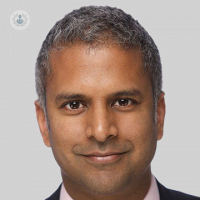A look at skull base cancers and their treatment
Escrito por:A skull base cancer is a malignant tumour that can start in the linings of the nose, the ear, eyes, facial skin or the scalp, before spreading to the base of the skull. There can be many different types, most of which are relatively rare. Sometimes, skull base cancers spread from a metastasis from a primary cancer that has developed in the lungs, kidneys or breasts, for example.
Mr Priy Silva talks to us a bit more about skull base cancers, the signs and how these cancers are treated.

What does skull base mean?
The skull base is that part of the skull that runs from the eyes to the back of the head. It separates the brain from the eyes, nasal cavity, ears and neck.
Important blood vessels such as the carotid arteries (that supply the brain) and nerves like the cranial nerves can be found in the skull base. Cranial nerves are responsible for sensory functions like smell, taste, sensations and hearing. They are also involved in swallowing, balance and making sounds with the voice box.
What causes skull base cancers?
The exact cause of many skull base cancers is unknown. Some cancers that start in the mouth and nose might be related to smoking. Other times, the cancer may be caused by exposure to a known hazard like wood dust for those people who cut or work with wood. Skull base cancers are rarely linked to genetics or previous exposure to radiotherapy.
What are the symptoms of skull base cancers?
Initial symptoms depend on where the cancer started. Cancer starting in the nose may manifest as a blocked nose for weeks with nasal discharge or blood. Tear ducts may become blocked as the cancer progresses and the patient may experience watery eyes or numbness of the face.
Cancer starting in the ear canal can be similar to an ear infection that doesn’t go away. There may be ear discharge, ear pain and even muscle weakness on the side of the face around the affected ear. Skull base cancers can also present as one-sided facial pain that increases in intensity and as numbness of the face. Unfortunately, as skull base cancer can present as an earache or simply a blocked nose, many patients don’t seek urgent medical attention and often don’t report symptoms for months.
How do you diagnose skull base cancer?
Skull base cancers are diagnosed using a number of tests, such as scans of the head and neck and a biopsy.
Scans include a CT (CAT scan), to look closely at the bone and an MRI to provide information about soft tissues and nerves. Further scans are also carried out to confirm that the cancer hasn’t spread to other parts of the body and usually include; a full-body CT and sometimes a PET scan. The biopsy can confirm the cancer, the type of cancer and where it originated from. After these tests, the type of cancer and course of treatment to follow can be determined by the doctor.
How are skull base cancers treated?
Treatment will depend on the type of cancer. The course of treatment should be decided at a skull base MDT meeting, where a group of experts decide on the right course of treatment for the patient.
Most skull base tumours are treated with combination multimodality therapy. This therapy is usually surgery, followed by radiotherapy. Some skull base cancers need chemotherapy, while proton therapy is another option.
Treatment doesn’t always aim to cure the cancer, as this may not be possible in some cases, however, treatment can slow down the progression of the cancer and reduce its effects. It can also control the cancer so that it doesn’t spread elsewhere.
What does skull base surgery involve?
Surgery to remove the tumour is very complex and requires very specialised surgeons. Your doctor will talk you through whether or not you need surgery to remove the cancer and what’s involved.
Surgery usually involves a team of surgeons, including an ENT head and neck surgeon, neurosurgeon and occasionally a plastic surgeon. The surgery itself involves removal of the cancer, followed by reconstruction work if needed. To reduce the number of cuts on the face, surgeons usually perform keyhole surgery or endoscopic surgery. The reconstruction work involves taking tissue from another part of the body (back, arm or abdomen) and transferring it to the surgery site. This is called free flap surgery. This is a very complex surgery that needs to be carried out by highly-trained specialists.
Discover more about head and neck surgery with Mr Priy Silva.


